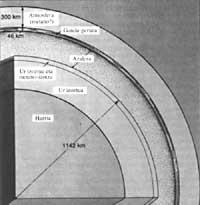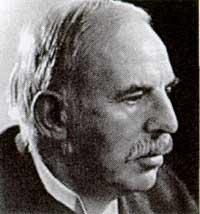From the atom to Pluto
2000/05/01 Kortabarria Olabarria, Beñardo - Elhuyar Zientzia Iturria: Elhuyar aldizkaria
The atom is something small, too small suddenly to see, describe and understand its characteristics. Maybe that's why, XX. In the fourth decade of the 20th century, intense research on the atom was carried out." The first notable date is 1932, when physicist James Chadwick discovered neutrons.
When years earlier the Rutherford group determined the number of protons in the nucleus of the atom, it became clear that protons were not enough to explain the mass of the nucleus. Rutherford himself, although unable to prove it, indicated the presence of a neutral particle in the nucleus of the atom and called neutrons. Chadwick found that there were neutrons and that their mass was similar to protons. At the turn of these years other particles were discovered in the structure of the atom, such as positrons (1931) and mesons (1935).
Therefore, the atom was not as simple as it was thought and for its study High Energy Physics was developed. In 1932, Joh Cockroft and Ernest Walton used nuclear energy to demonstrate the division of the atom. Two years later, the Curie marriage discovered artificial radioactivity. In this sense, chemist Otto Hahn formulated the theory of nuclear fission, explaining that the bombardment of uranium atoms with neutrons would provoke an energy liberating reaction. At the end of the decade, uranium atoms were divided to obtain fission. He was informed by the Danish physicist Niels Bohr.
Like High Energy Physics, new lines of research began in those years. They came to understand the nature of metals and insulators and the origin of semiconductors. And this was of great importance for the development of electronics, telecommunications, metal physics and solids... In addition to physics, Chemistry created a new line of research, Quantum Chemistry.
Advances in the media were important. American engineer Edwin Armstrong invented the FM radio system and managed to avoid the problem of interference. Implementation in Berlin of the first television service. Although low-definition, 180 lines, the Berlin Olympic Games were broadcast (1935). Three years later, Russian electronic engineer Vladimir Zworykin patented the cathodic ray tube, the heart of television.
The radar system, that is, the system of detection and location of objects by radio waves, is then. According to most historians, the first radar was used by the British Army's Sheffield cruiser in 1939, while others considered that the honor corresponds to the French ship Normandie, which was placed in 1936 to locate the ice cubes.
Although electronics issues seem more modern, the electronic microscope is a tool created in the 1930s. The inventors were the Germans Ernest Ruska and Max Knoll in 1931. When presented it multiplied by 17 objects, and two years later was able to increase 12,000 times objects. Currently the maximum magnification of microscopes is 160,000 paths.
Many researchers were still looking to the sky, what to find. The last planet in the Solar System was discovered in 1930. The finding was by Clyde Tombaugh, but there were also those who years before said that there could have been the ninth planet, Percival Lowell. Tombaugh checked Lowell's belief, discovered the planet Pluto.
One of the main novelties was the helicopter between the means of transport. It was removed by the Soviet Igor Sikorski in 1939. In the airfield there was also a revolution in 1930. Two English and German engineers designed an engine that worked directly under the principle of action and reaction. There were also setbacks, accidents. The Hindenburg guided ball accident in 1937 marked the end of the era of guided balls.
In the field of scientific and military calculation, the development of analog technology took place in the 1930s. At the beginning of the decade the American Vannevar Bush invented the first computer or analog calculator. Later new calculation tools were created. For example, the giant calculator Mark 1 was started at Harvard University in 1937.
In addition to these inventions and advances, there were many more: Refrigerator with freezer (1931). Stereophonic recordings (1933). Double helix thread for bulbs (1934). First antibacterial drug, sulfanilamide (1935). Electric guitar (1935). Slide coils (1935). Photocopy (1937). DDT pesticide (1939). New materials, plexiglas (1930), nylon (1935), teflon (1938), etc.

Gai honi buruzko eduki gehiago
Elhuyarrek garatutako teknologia





